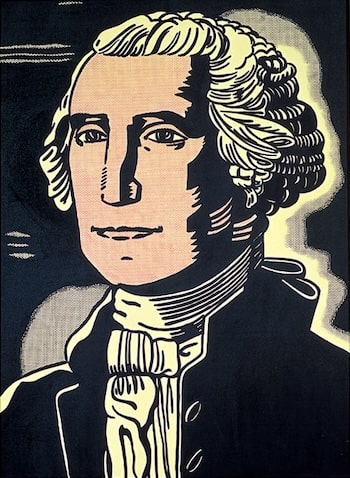George Washington, 1962 by Roy Lichtenstein

Roy Lichtenstein mined the visual cliches of illustration, embracing the look of mass-produced images in his paintings. George Washington, an early work by the artist, was created
while he was focusing on black-and-white, single-object paintings of ordinary commercial products.
Throughout his career, Lichtenstein referenced art-historical sources in his painting. Based on a woodcut version of Gilbert Stuart's portrait of the first American president, found in a
Hungarian national newspaper, Lichtenstein's canvas also references the likeness of George Washington that appears on the one-dollar bill.
Simplified in the artist's characteristic graphic style, this image includes red and black Benday dots that create the illusion of volume while referencing the flat reproduction of the printing
process.
In George Washington Lichtenstein uses the unartistic drawing style of the comic strips to convert a formidable subject into an image that looks like a reproduction. His image refers
to the image of the president engraved on a dollar bill as well as to heroic portraits painted by artists such as Gilbert Stuart. By using the mechanical process of reproduction in his
painting, Lichtenstein is able to remind the viewer of the dollar bill, but because the portrait is authoritative and its subject conventional, he can also recall "official" portraiture.
Thus Lichtenstein's figure of the first president of the United States is as imposing as any "official" portrait and as absurd as his caricature on a dollar bill: an apt description of
the nature of official art in our culture. In his painting of George Washington, Lichtenstein created a stunning portrait from a sequence of spare blackand-white shapes and added a series
of red benday dots to the face to simulate the color in the Stuart painting. His use of the ubiquitous benday dot and black and white to evoke simultaneously volume and flatness is one
of the more astounding feats of his early work, as is his ability to convert a stereotype into a compelling image.
